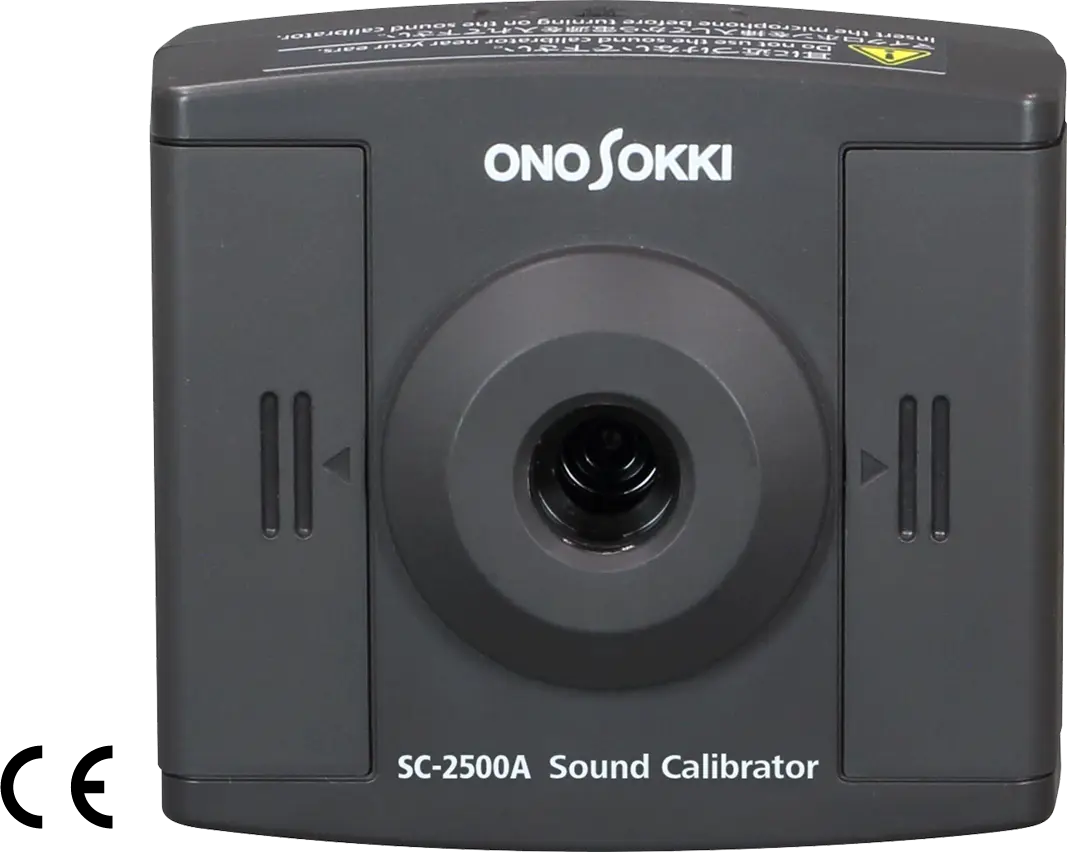What is sound level meter?
Sound calibrators specified in IEC 60942 (JIS C 1515) are used to calibrate sound level meters including microphones.
There are two types of sound calibrators: the piston-phone type which generates reference sound pressure using fixed-cycle mechanical vibration; and the simple type which nomal cone speaker. Ono Sokki offers the SC-2500A dynamic speaker model (IEC 60942:2017, JIS C 1515:2004 Class1) and the simple SC-2120A model (IEC 60942:2003, JIS C 1515 Class 2). The SC-2500A generate a sound pressure of 114 dB (250 Hz) while the SC-2120A generates 94 dB (1 kHz). Before starting measurement, enter the sound calibrator’s reference sound pressure, set the frequency weighting to either FLAT or C and ensure the reading agrees with the reference sound pressure. If necessary, use the adjustment knob to eliminate any disagreement. A difference of 2 dB or more suggests a fault; contact Ono Sokki for inspection.
 SC-2500A |
|
|
|
Figure 7-2: Sound calibrators |
||
The internal reference signal output function (REF) of a sound level meter is used to generate stable 1000 Hz calibration signals within the sound level meter that correspond to 1/2 (= −6 dB) of the full scale (100 %) of the level range to check the function of the electric circuit. These signals are used for simple routine check and as calibration signals for externally connected devices such as level recorders and FFT analyzers.
NOTE: 1. IEC 61672-1:2002 (JIS C 1509-1:2005) only allows acoustic adjustment using sound calibrators meeting IEC 60942:2003 (JIS C 1515:2004) as a means of calibration and inspection (adjustment) for sound level meters. Calibration using internal reference signals (1 kHz sine wave CAL signals) is therefore not the standard form of calibration. 2. As the microphone is under high electrostatic stress, moisture can cause electrostatic sparks that may make a hole in the diaphragm. |
7-4 Measurement ranges of sound level meters (Linearity ranges)
The level linearity errors of sound level meters conforming to IEC 61672-1:2002 (JIS C 1509-1:2005) at A-weighted, C-weighted and Z-weighted sound pressure levels are specified (with expanded measurement uncertainty taken into account) as follows:
| Class 1 precision sound level meters | ±1.1 dB |
| Class 2 standard sound level meters | ±1.4 dB |
The allowable variations in fluctuations of +/-10 dB at given signal levels in level ranges are specified (with expanded measurement uncertainty taken into account) as follows:
| Class 1 precision sound level meters | ±0.6 dB |
| Class 2 standard sound level meters | ±0.8 dB |
If any signal that causes linearity deviation to go beyond the allowable variation range is input, "Over" (level too high) or "Under" (level too low) will be displayed as an out-of-the-measurement-range warning.
The measurement range (linearity range) of a sound level meter is defined as an operating range in which "Over" or "Under" is not displayed with any frequency weighting, range or frequency.
In brochures, the linearity range at 1 kHz is normally stated as the nominal specification because the measurement range can vary depending on the conditions mentioned above. Operation manuals usually include a table of nominal upper ("Over") and lower ("Under") limits at the following frequencies with each weighting type.
| Class 1 precision sound level meters | 31.5 Hz, 1 kHz, 4 kHz, 8 kHz, 12.5 kHz |
| Class 2 standard sound level meters | 31.5 Hz, 1 kHz, 4 kHz, 8 kHz |
7-5-1 Why is a wind screen necessary?
A wind screen reduces wind noise around the microphone. When installed on the microphone, an ideal wind screen significantly reduces wind noise without severely affecting the acoustic characteristics of the microphone.
Wind microphones are generally classified into two types: the general-purpose type (normally spherical in shape and made of urethane foam) that can be easily installed for measurement and then removed and that protects the microphone from dust and other foreign matter while lessening external physical impact; and the all-weather type for extended, continuous measurement of aircraft, factory and other types of noise that significantly reduces wind noise while being resistant to rain, snow and other elements. Wind screens are recommended for outdoor noise measurement.
7-5-2 Performance of general-purpose wind screens
In most cases, general-purpose wind screens are used on handy-type microphones. This type of wind screen must be capable of reducing wind noise to certain levels, be easy to attach and detach from the microphone, and match the microphone in design.
The wind noise reduction effect of a wind screen can be expressed as the difference between the level of noise generated around the microphone when directly hit by wind and the level of noise generated around the microphone covered with the wind screen. Wind noise reduction effect is known to depend on the size of the wind screen.
Doubling the diameter of the wind screen results in a noise reduction of around 6 dB. Ono Sokki’s sound level meters are supplied with a wind screen of one of the two types, whichever is more suitable for the meter. The LA-1410, LA-1440 and LA-4440 series are supplied with a φ70 mm wind screen. The LA-2111 and LA-5000 series are supplied with a φ90 mm wind screen. Figure 7-4 shows the performance of these screens. When measuring outdoor environment noise (60 dB or above), a φ70 mm wind screen and a φ90 mm wind screen can be used effectively up to a wind velocity of around 3 m/s and 5 m/s, respectively.
|
Figure 7-3: Wind screen performance |
|
Figure 7-4: Wind screen fitted on LA-1400 sound level meter |
7-5-3 All-weather wind screens
All-weather wind screens are recommended for outdoor measurement in snow, rain or other bad weather. Figure 7-6 shows an example of Ono Sokki’s all-weather wind screen (an option) connected to a sound level meter. As shown in figure, an extension cable is also needed to connect the microphone to the sound level meter.
|
Figure 7-5: All-weather wind screen fitted on sound level meter |